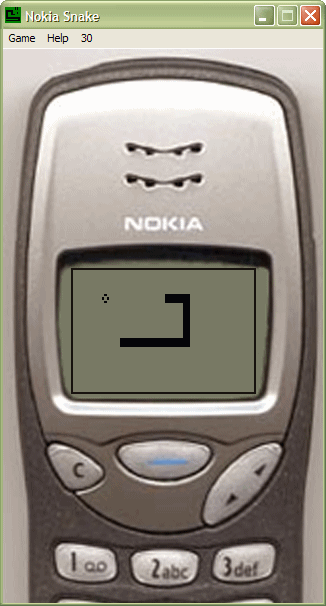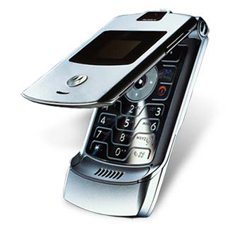Land-line became a punchline.
GREAT MOMENTS IN CELL PHONE HISTORY
"Snake" on Nokia Cell-Phones

Remember your first cell phone? What brand was it? When did you get it? I think I know the answer. I have taken a very informal survey to determine when most people got their first cell phone (I know I could just look at sales statistics but, this is a lot more fun.) and, shockingly, the answer is almost uniformly consistent: 2001. It seems that the second year of our decade was the watershed moment when a cell-phone went from a luxury to a necessity. Almost overnight, to not have a cell phone was to be divorced from modern life. The pager, now frozen in time as an emblem of the 90's, went from being wildly popular to antiquated as the telegraph. Cell phones were not the future by 2001, they were now. And, if you're like me, your first phone was probably a small Nokia with a monochromatic screen, like the one shown above. These phones were everywhere. Decidedly primitive by today's standards, these were ultra-portable communication devices that were cheap enough to be adopted by people from coast to coast in an amazing shopping frenzy. Nokia quickly became the market leader (and still is). And what gave Nokia the edge? It had to be...Snake!
Though these days you can play the latest photo-realistic FPS or the entire 8-bit Nintendo catalog on your mobile, I contend that the most addictive game possible for a portable device was Nokia's classic upload of Snake. A snake, symbolized by a little dark line, consumes morsels of food, each morsel making his body grow that much longer. The snake once in motion cannot be stopped and it's up to the player, manipulating the snakes direction, to make sure he doesn't ever eat his own tail. I lost hours upon hours of time snaking around. (You can download the original Nokia game here.) Snake was the first clue that cell phones are going to be about a lot more than audio communication.
It was also with these rudimentary phones that the real number one feature of cell phones came into focus: texting. See, I have always loathed talking on the phone. I like to look people in the eye when I talk to them, preferably over an alcoholic beverage for conversational lubrication. I find phone conversations awkward to end and weighed down with too much idle chatter. And yet, communication whilst separated in space from another individual is a necessity. (How else are you going to know where to meet for drinks in the first place?) A text, a short direct written communication between two cell phones, solves all these problems. It's also obsessively fun. My mobile is really a text machine which I sometimes use it for phone services. I am not alone.
The Blackberry
 The most forward-thinking of cell phones, the Blackberry-5000 series, with it's E-Mail capabilities and rudimentary web browsing, became the first popular "smartphone" in America in 2002. Quickly becoming an object as synonymous with businessmen as the briefcase, the Blackberry user - in a three button suit, checking his email as he dashes down the street - is an iconic persona of the decade. So addictive the device has been nicknamed "crackberry," the Blackberry was the first popular consumer gadget that foresaw the convergence of functionality as the future of the business. Not content to merely provide phone service, the blackberry wanted to do it all. And did.
The most forward-thinking of cell phones, the Blackberry-5000 series, with it's E-Mail capabilities and rudimentary web browsing, became the first popular "smartphone" in America in 2002. Quickly becoming an object as synonymous with businessmen as the briefcase, the Blackberry user - in a three button suit, checking his email as he dashes down the street - is an iconic persona of the decade. So addictive the device has been nicknamed "crackberry," the Blackberry was the first popular consumer gadget that foresaw the convergence of functionality as the future of the business. Not content to merely provide phone service, the blackberry wanted to do it all. And did.The phones greatest advertisement was none other than it's unofficial pitchman President Barack Obama who throughout the campaign was often photographed checking his Email or making a call on the device. After a hard fought battle, the President got permission to keep his Blackberry (a custom made, one-of-a-kind, security cleared Blackberry no less), all but securing sales for the company for years to come.
The RAZR

 Chicest of the cells, the RAZR was the first cell phone to double as fashion accessory. Released for a whopping $600 in 2004, the RAZR began life as a kind of high end luxury item for money-oblivious fashionistas. After the price was dramatically lowered by 2006, the phones cache had already been established. It sold like gangbusters. In retrospect, the RAZR represented the pinnacle of the cell phone as cell phone. With smartphones taking over the entire market in ever more rapacious succession, its now the end of the cellphone as we once knew it. (The phone itself being but one in a panoply of features on the newer smartphones.) The RAZR was the most stylish, most publicized, most media friendly cell phone ever released. At last, design had met utility, form had met function. An iconic object of the Aughts, the RAZR was the cell phone's most commanding cultural moment. In only three years after its release a little product by a fruit company would all but demolish its cultural dominance.
Chicest of the cells, the RAZR was the first cell phone to double as fashion accessory. Released for a whopping $600 in 2004, the RAZR began life as a kind of high end luxury item for money-oblivious fashionistas. After the price was dramatically lowered by 2006, the phones cache had already been established. It sold like gangbusters. In retrospect, the RAZR represented the pinnacle of the cell phone as cell phone. With smartphones taking over the entire market in ever more rapacious succession, its now the end of the cellphone as we once knew it. (The phone itself being but one in a panoply of features on the newer smartphones.) The RAZR was the most stylish, most publicized, most media friendly cell phone ever released. At last, design had met utility, form had met function. An iconic object of the Aughts, the RAZR was the cell phone's most commanding cultural moment. In only three years after its release a little product by a fruit company would all but demolish its cultural dominance.The iPhone

There is a before and then there is an after. There is before JFK was assassinated and there is after. There is before Alexander Graham Bell called Watson into his office and there is after. There is before the Emancipation Proclimation and there is after. Equally so, there is before the iPhone and there is after.
Upon release the iPhone was given the sobriquet of "Jesusphone" and not undeservedly. Here was, at long last, a gadget of our dreams. The title iPhone was actually something of a misnomer. Yes the iPhone was the best, most effortlessly usable, most feature rich cell-phone ever made but, that was just the tip of the iceberg. Nothing short of a mini-Mac, the iPhone was a fully realized web-browser, calendar, Email service, camera, iPod, GPS (in it's second model) and, eventually, 3rd-Party platform for a ever-growing sea of applications. The touch interface was both intuitive and revolutionary (and perfect); the click-wheel of the iPod might as well be tossed into the dustbin of tech history, next to punch cards and the abacus. It's original price point of $500 was the only aspect of the phone that slowed it from total world domination, the amount being just too cost-prohibitive for many, despite the myriad features. When the price was eventually lowered to $200 the excuses anyone once made in avoidance were dried up. The iPhone was the Jesusphone indeed, the second coming of mobile devices and the death knell for the first era of cell phone culture. Picking up an incoming call, while surfing the net (in full HTML glory), after reading your daily E-Mail and updating your calendar appointments, it's sobering to remember that just 6 years ago you were playing Snake on a small, peaked looking screen. That, my friend, is what the Aughts were all about.
You AUGHT to remember...

No comments:
Post a Comment